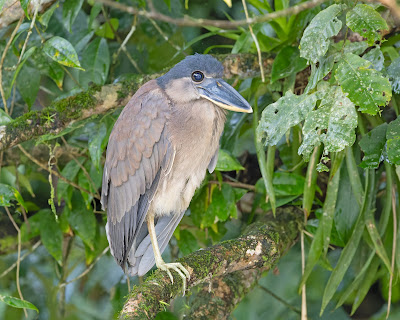Tuesday, January 23, 2024
Our main event this morning was a boat ride to look for some specific birds like Kingfishers, Herons, and other water-dependent species. Our boat captain had suggested moving the starting time from 6:00 to 6:30 based on forecast overcast conditions, but we wished we’d left at 6:00 because it was clear.
While we waited at the dock we saw a few nice birds and a huge iguana in a tree on the other side of the river.
We got underway, and started seeing Egrets, Herons, Cormorants and Anhinga everywhere.
This is such a rich area for waders and divers. We saw one of our favorite birds, a Boat-billed Heron. This is a nocturnal heron named for its oversized bill.
We headed directly to a spot where we left the boat and made a short hike to an inland lagoon where we would look for our first target, the Agami Heron.
Unlike most herons this one lives in forested areas and tends to hide on brushy riverbanks. We located one that was partially concealed in some branches, but eventually it moved out into a more open area before flying off.
Many people consider it the most attractive of the herons and we would agree. We’d seen this bird very poorly in Belize in 2005 and hadn't seen it since, so we were very happy to be able to watch it for about 30 minutes and get some really excellent views.
While viewing the heron we also saw a tiny Pied Puffbird way up in a tree, and a Roseate Spoonbill wading nearby.
We got back into the boat and headed down the river to find our next target, the Green-and-rufous Kingfisher. Of the six species of kingfishers in the Americas, this one is the toughest to find. We saw our first in 2018 in Panama and have not seen one since. We spotted one in some dark branches overhanging the river and our captain maneuvered the boat in for great looks and pictures.
We also saw plenty of Ringed, Amazon, and Green Kingfishers along the river, missing only the tiny American Pygmy Kingfisher and the Belted Kingfisher. It is interesting that the Belted Kingfisher is abundant throughout North America and the only kingfisher to be found in most of the United States. But here in Costa Rica it is relatively rare and harder to find than all but the Green-and-rufous.
As we cruised the river we saw dozens of different Egrets, Ibis and Herons.
Our captain located a Common Potoo roosting in a tree, looking just like a dead branch, and later a well-hidden Pacific Screech-Owl, which was a life bird for us.
We returned to the dock at 9:30 and headed off to bird a short forest trail and check out some lagoons. The day was heating up quickly, and being out in the open was pretty warm. But there was a good breeze and much of the time we were in the shade of the forest, so it was tolerable. Teri and I posed at a sign urging folks to prevent forest fires. I'm the monkey, she's the sloth, in case you were wondering...
On the trail we got good looks at a pair of Black-headed Trogons, as well as a Black-striped Sparrow gathering nesting material.































I really am enjoying the trip to Costa Rica through your writings. Great pictures and captions, as always.
ReplyDeleteThanks Virginia. I hope that all is going well in South Texas. I guess that you be leaving soon?
DeleteLunch looks delicious. I like how that one bird was going for the invasive species fish. I’m sure it was coincidence, or availability, but it would be nice if those things could be trained! Too often it seems another new species is introduced to eradicate one and the cycle continues. Serene
ReplyDeleteThe birds were really cleaning up on those catfish! So there is some control happening.
Delete